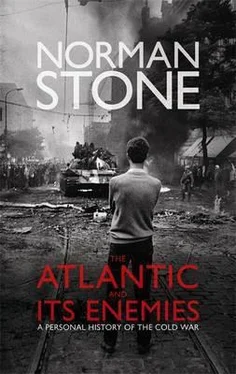In June 1947 Marshall spoke at Harvard and launched into a speech that entered history as one of America’s most positive contributions ever. Veteran diplomats who knew Russia drafted it (Kennan and Bohlen) and their words were carefully chosen — for instance, there was no overt anti-Communism and the Russians were invited to the initial conference (in Paris) to discuss things. The Marshall Plan was ingenious. It was presented as a design to put Europe back on its feet, thousands of millions of dollars being on offer, generally as a gift. That in itself offered hope in the bread queues, and the USA at the time counted as a land of milk and honey, a place of wizardry in typewriters and refrigerators. That in itself would counter any appeal that Communism might have. But the Plan also squared another difficult circle. Western Europeans blamed their own lack of recovery on the failure of the Americans to deliver reparations from Germany, and the Americans had let this happen (in May 1946) because they would have had to pay still more for a stricken Germany. But if Germany were allowed to recover, there were many, many Europeans who would fear the worst, given the German past. But without German recovery, as Hoover had stressed, there would be no overall European recovery given that, for instance, half of Holland’s exports generally went there.
Marshall presented German recovery in the context of overall European recovery, and in the summer of 1947 the Americans informally discussed the political unification of ‘Bizonia’ with the British. This was the restart of Germany: in April, at Frankfurt, an ‘Economic Council’ of fifty-two delegates chosen by the Länder parties had met. ‘Reparations’ were scaled down to permit the Germans to produce 10.7 million tons of steel. ‘Bizonia’ was formally included in the European Recovery Program, as the Marshall Plan was formally called, and after a conference of sixteen European nations in July, including Turkey, a project was submitted in September for increased output and exports, for financial stability and cross-border co-operation. The cost was put at $20bn. The winter had vastly weakened ideas of ‘socialism’, and liberalism, as the Europeans understood it, was coming back again. Marshall obviously meant capitalism, New Deal style, and it floated in on the tide of $40bn that the Americans disbursed in the second half of the forties. This was needed the more because the summer turned out in its way to mark more disaster: there was a drought, and the French had the smallest wheat crop for 132 years; extra rations had to be given to the Ruhr miners in a desperate effort to increase coal production. Importing food, France and Italy found their dollar reserves melting, and such private capital as was free to do so shifted to the USA. There was a run on the pound sterling, and as Truman wrote, ‘the British have turned out to be our problem children now. They’ve decided to go bankrupt and if they do that it will end our prosperity and probably all the world’s too.’ Late in September he told congressmen and said that some interim help (before the Plan started) was essential, ‘or… for all practical purposes Europe will be Communist’. A new international Communist organization had been set up, Cominform, and the French and Italian parties had been instructed to start disruption through strikes and industrial trouble: in fact, news that ‘in France the subway and bus strike is spreading’ caused congressmen to accept Truman’s proposal for a special session, at which the American people could be persuaded to endorse the Marshall Plan. A special session did then authorize a further $600 million as interim aid to Austria, France and Italy.
There was a final postscript when the next Council of Foreign Ministers assembled in November in London. By then, Marshall had no expectation of Russia: she would try to ‘get us out of western Germany under arrangements which would leave that country defenceless against communist penetration’. One such ‘ruse’ would obviously be to accuse the Western powers of dividing Germany, with the establishment of a separate state there (and some Germans did argue that siding with Russia would mean a united and neutral Germany). In due course Molotov was utterly intransigent, and, now, the French came round to the American side, at last willing to accept the principle of a sovereign Germany. Such plans included a currency reform, which would obviously mark off the western zones from the east, which would retain the old, managed, currency. At American initiative, the Council was broken off on 15 December. European reconstruction, under the Marshall Plan, now went ahead.
Over a five-year period, $13bn was given to European countries, including Turkey, and that amounted to 2.5 per cent of the entire American economy. In the first year — 1948-9 — over $5bn went, in accordance with the recommendation of a committee set up under Averell Harriman. For a government to collect sums of that sort was remarkable enough but so too was the degree of international co-operation involved. The European Recovery Program (ERP) financed about one third of all exports, and a central office in Paris, the Committee for European Economic Co-operation, collected the statistics of what was needed, and allocated the dollars to pay for them (in April 1948 it became ‘Organization’ and subsequently became the Organization for Economic Co-operation and Development, today’s OECD). That took time, and a large staff, some of them working in the various countries to check on the statistics and the needs. The Plan operated properly only in 1948-9, when it made a significant contribution to the overall GNP of between 5 and 10 per cent. An Economic Co-operation Administration (ECA) was opened in Washington to supervise the statistics-collecting and co-ordinate it with American spending. There were some grumblers on the Right who did not like this government largesse. Certainly, it amounted to a subsidy for American producers, and the lobbyists got to work — half of the ERP shipments to go in American bottoms, and a quarter of the flour to be sent ready-milled.
German industry was essential, and the Economic Council in Frankfurt became a proto-government, with six ‘directors’ as technical ministers. By February 1948, when the European Recovery Program got under way, there were 104 deputies and by June 1948 there was a prototypical central bank, with the unwieldy name ‘Bank of German Lands’, the ‘the’ omitted because the ‘lands’ did not include the eastern-zone ones. In May 1947 the Christian Democratic Union emerged as a Bürgerblock dominated by Konrad Adenauer. Quite soon, in July 1948, the ministers-president of the Länder were authorized to set up a constitutional convention, and ‘Bizonia’ had its own people in the Marshall offices in Paris. There were still wrangles with the French, who wanted the Saarland’s coal, and there were still debates about ‘reparations’ in 1949, but these were echoes of old shouting, and in summer 1948 the French Zone was to be added to the other Western ones, as a ‘Trizonia’. An agreement at Washington in April 1949 agreed the bases for a new Germany.
The Marshall Plan counted as enormously successful. There were some imponderables. For Americans at that time, Europe was a place of endless interest. As a young CIA man of the time, Michael Ledeen, said, its films, wines and women were endlessly fascinating and stood at great contrast to the tea and cookies on offer at home. It was a sort of emancipation. Nan Kempner, wife of a banker stationed in London, was full of admiration for the stoicism of her British friends, giving dinner parties in the midst of severe rationing; she said she found a way of leaving money on the mantelpiece discreetly; Zara Steiner, then studying at Oxford, also found the place exotic, as champagne fountains flowed for summer balls in bread-rationed and then drought-ridden 1947. Fifty thousand people applied for ECA jobs, of which there were 3,701, 2,612 abroad. There was a further imponderable. The myth of Roosevelt grew as time went by. In his lifetime, he had had enemies. But in the later 1940s and 1950s he came to be seen in a golden glow. The New Deal had made for superb propaganda, as public money was poured, with conviction, into the sort of giant engineering projects that distinguished America — especially the Tennessee Valley Authority, designed to irrigate a huge area with dams or river diversion (the original plan was, as it happens, Hoover’s, and has subsequently been much criticized for its effects on the ecology). The New Deal of the 1930s may not have immediately solved America’s problem with unemployment, but the Second World War certainly had, and the American war economy had been one of the world’s wonders. This war economy, thought the people who managed it, just showed what could be done if the government and business co-operated, with government applying controls (as over petrol rationing) when this had to be. A young economist, John Kenneth Galbraith, rose to positions of power and influence. He had trained at Cambridge with J. M. Keynes and had been beguiled by the ease with which Keynes, himself apparently a grandee, took on the grandees of the ‘orthodox’, stuffy financial world, associated with the old and staid virtues. Galbraith, who went on to write very good books and convincing articles about the modern economy, had controlled some prices during the war. He was, instinctively, a believer in the power of government to liberate people from the bad barons or wicked capitalists or stupid bankers who might attempt to rule their lives. Roosevelt had died in April 1945, just before the end of the war in Europe. But his soul went marching on. The Americans who came to Europe in the Marshall Plan period had a wonderful time. Their attitude (‘can do’) came straight from the New Deal and the war. Now it was on display in Europe. Especially in Germany, it went down very well indeed. The Marshall Plan was the application of New Dealing to Europe. The thirties had been a bleak decade for foreign trade, with quotas, exchange controls and highly complex trade agreements between one country and another, striving for balance, and consuming vast amounts of paper in the effort to work out how many exported turnips translated into an imported locomotive. Exports in 1946 stood at only 60 per cent of the figure for 1938 — itself a poor year, given rearmament and the near withdrawal of Germany from the international arena. That was set to change.
Читать дальше












![Edward Ellis - Adrift on the Pacific - A Boys [sic] Story of the Sea and its Perils](/books/753342/edward-ellis-adrift-on-the-pacific-a-boys-sic-s-thumb.webp)